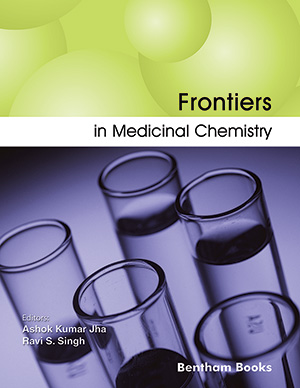Abstract
Molecular imaging can be used to evaluate the spatial–time change of the molecular biological phenomenon of the cell–molecule level in living bodies. Molecular imaging technology is expected to be applied in the fields of drug development, clinical diagnosis, and life science research. Specifically, positron emission tomography (PET) is a powerful non-invasive imaging technology for investigating physiological parameters in living animals using compounds labeled with PET radioisotopes as molecular probes. This review summarizes and compares various 18F-conjugation techniques that employ the chemical and enzymatic reactions of different types of tumor-targeting biological molecules such as peptides, proteins, antibodies, and nucleic acids.
Keywords: Chemoenzymatic reaction, Chemical reaction, Positron emission tomography (PET) probe, Biologics, Biopharmaceutics, Fluorine-18 (18F), Peptide, Protein, Oligonucleotide, Antibody, Click chemistry, Tumor targeting.
Current Topics in Medicinal Chemistry
Title:18F-Containing Positron Emission Tomography Probe Conjugation Methodology for Biologics as Specific Binders for Tumors
Volume: 16 Issue: 24
Author(s): Kenji Arimitsu, Hiroyuki Kimura, Yoshinari Arai, Kazuto Mochizuki and Masumi Taki
Affiliation:
Keywords: Chemoenzymatic reaction, Chemical reaction, Positron emission tomography (PET) probe, Biologics, Biopharmaceutics, Fluorine-18 (18F), Peptide, Protein, Oligonucleotide, Antibody, Click chemistry, Tumor targeting.
Abstract: Molecular imaging can be used to evaluate the spatial–time change of the molecular biological phenomenon of the cell–molecule level in living bodies. Molecular imaging technology is expected to be applied in the fields of drug development, clinical diagnosis, and life science research. Specifically, positron emission tomography (PET) is a powerful non-invasive imaging technology for investigating physiological parameters in living animals using compounds labeled with PET radioisotopes as molecular probes. This review summarizes and compares various 18F-conjugation techniques that employ the chemical and enzymatic reactions of different types of tumor-targeting biological molecules such as peptides, proteins, antibodies, and nucleic acids.
Export Options
About this article
Cite this article as:
Arimitsu Kenji, Kimura Hiroyuki, Arai Yoshinari, Mochizuki Kazuto and Taki Masumi, 18F-Containing Positron Emission Tomography Probe Conjugation Methodology for Biologics as Specific Binders for Tumors, Current Topics in Medicinal Chemistry 2016; 16 (24) . https://dx.doi.org/10.2174/1568026616666160413125948
| DOI https://dx.doi.org/10.2174/1568026616666160413125948 |
Print ISSN 1568-0266 |
| Publisher Name Bentham Science Publisher |
Online ISSN 1873-4294 |
Call for Papers in Thematic Issues
Chemistry Based on Natural Products for Therapeutic Purposes
The development of new pharmaceuticals for a wide range of medical conditions has long relied on the identification of promising natural products (NPs). There are over sixty percent of cancer, infectious illness, and CNS disease medications that include an NP pharmacophore, according to the Food and Drug Administration. Since NP ...read more
Current Trends in Drug Discovery Based on Artificial Intelligence and Computer-Aided Drug Design
Drug development discovery has faced several challenges over the years. In fact, the evolution of classical approaches to modern methods using computational methods, or Computer-Aided Drug Design (CADD), has shown promising and essential results in any drug discovery campaign. Among these methods, molecular docking is one of the most notable ...read more
Drug Discovery in the Age of Artificial Intelligence
In the age of artificial intelligence (AI), we have witnessed a significant boom in AI techniques for drug discovery. AI techniques are increasingly integrated and accelerating the drug discovery process. These developments have not only attracted the attention of academia and industry but also raised important questions regarding the selection ...read more
From Biodiversity to Chemical Diversity: Focus of Flavonoids
Flavonoids are the largest group of polyphenols, plant secondary metabolites arising from the essential aromatic amino acid phenylalanine (or more rarely from tyrosine) via the phenylpropanoid pathway. The flavan nucleus is the basic 15-carbon skeleton of flavonoids (C6-C3-C6), which consists of two phenyl rings (A and B) and a heterocyclic ...read more
 91
91 4
4 1
1 2
2
- Author Guidelines
- Graphical Abstracts
- Fabricating and Stating False Information
- Research Misconduct
- Post Publication Discussions and Corrections
- Publishing Ethics and Rectitude
- Increase Visibility of Your Article
- Archiving Policies
- Peer Review Workflow
- Order Your Article Before Print
- Promote Your Article
- Manuscript Transfer Facility
- Editorial Policies
- Allegations from Whistleblowers
- Announcements
Related Articles
-
Therapeutic Potential and Pharmaceutical Applications of <i>Cucurbita</i>
Current Nutrition & Food Science P-glycoprotein as a Drug Target in the Treatment of Multidrug Resistant Cancer
Current Drug Targets Targeting the Voltage-Dependent K+ Channels Kv1.3 and Kv1.5 as Tumor Biomarkers for Cancer Detection and Prevention
Current Medicinal Chemistry Omega – 3 Fatty Acids as Pharmacotherapeutics in Psoriasis: Current Status and Scope of Nanomedicine in its Effective Delivery
Current Drug Targets The Possible Involvement of Glycogen Synthase Kinase-3 (GSK-3) in Diabetes, Cancer and Central Nervous System Diseases
Current Pharmaceutical Design Female Infertility and Assisted Reproduction: Impact of Oxidative Stress-- An Update
Current Women`s Health Reviews Therapeutic Peptide Mimetics Looking for a Turn to Block Aberrant Players of Malignancy
Current Cancer Therapy Reviews A Compendium of Volatile Organic Compounds (VOCs) Released By Human Cell Lines
Current Medicinal Chemistry Insight View on Possible Role of Fluoroquinolones in Cancer Therapy
Current Topics in Medicinal Chemistry Oxidative stress and myocarditis
Current Pharmaceutical Design Melatonin Prevents Neddylation Dysfunction in Aβ42-Exposed SH-SY5Y Neuroblastoma Cells by Regulating the Amyloid Precursor Protein- Binding Protein 1 Pathway
Current Alzheimer Research Immunotherapy and Targeted Therapy Combinations in Renal Cancer
Current Clinical Pharmacology Metabolomic Heterogeneity of Urogenital Tract Cancers Analyzed by Complementary Chromatographic Techniques Coupled with Mass Spectrometry
Current Medicinal Chemistry A Medicinal Chemist’s Perspective Towards Structure Activity Relationship of Heterocycle Based Anticancer Agents
Current Topics in Medicinal Chemistry Monoclonal Antibodies in Clinical Oncology
Anti-Cancer Agents in Medicinal Chemistry Microarray RNA/DNA in Different Stem Cell Lines
Current Pharmaceutical Biotechnology Targeting the Nucleotide Metabolism Proteins of the NUDIX Family and SAMHD1 in Cancer
Current Medicinal Chemistry The Role of Phenolic Compounds in the Fight against Cancer – A Review
Anti-Cancer Agents in Medicinal Chemistry Regulatory Approaches to Nonclinical Reproductive Toxicity Testing of Anti-Cancer Drugs
Anti-Cancer Agents in Medicinal Chemistry Poly(ADP-Ribosylation): Beneficial Effects of Its Inhibition
Current Enzyme Inhibition
























